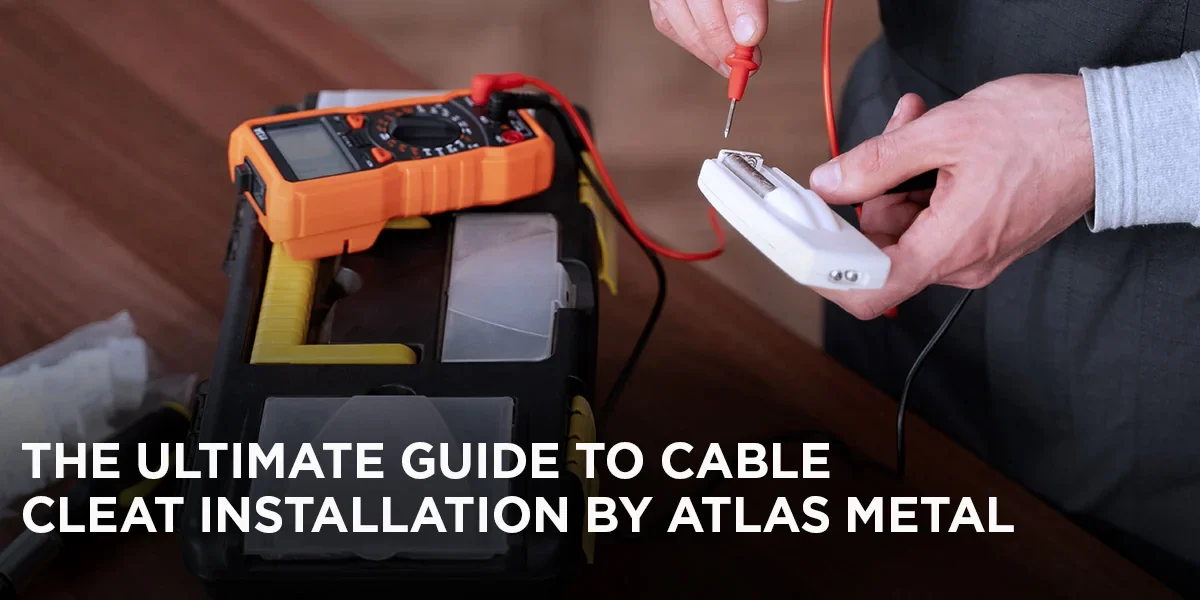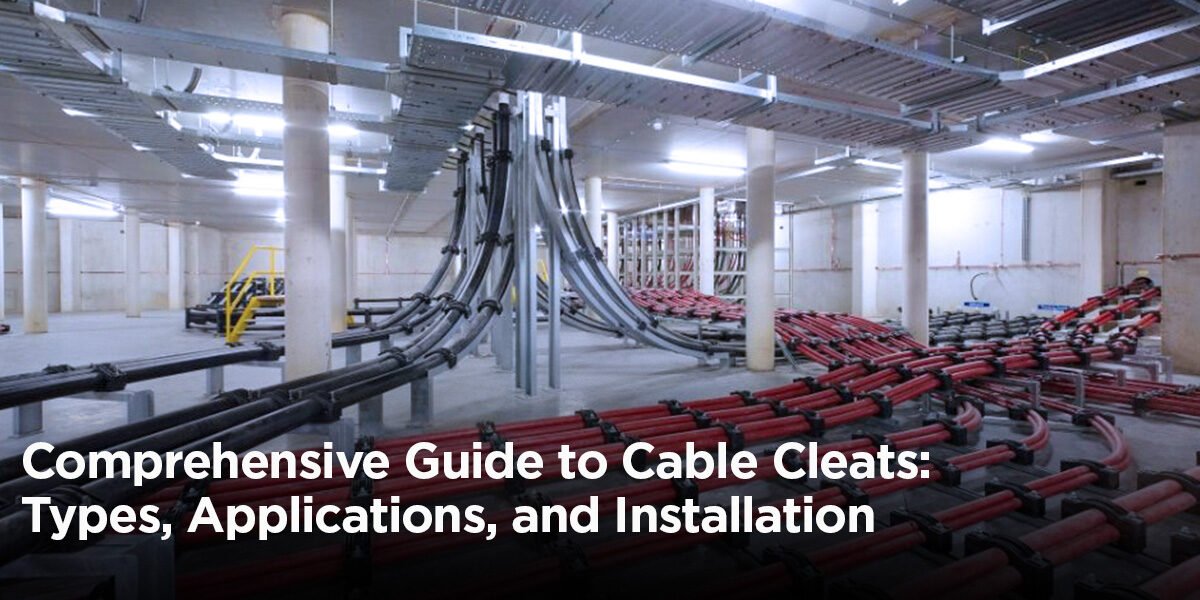In the realm of electrical installations, ensuring the stability and safety of cables is paramount. One crucial component that aids in achieving this is the cable cleat. Designed to secure and manage cables, cable cleats play a vital role in maintaining order and safety in cable management systems.
Atlas Metal, a leading cable cleat manufacturer based in Jamnagar, India, presents this comprehensive guide on cable cleat installation. This guide will cover everything from understanding cable cleats for electrical installations to maintenance and inspection, providing you with a holistic view of the installation process.
Cable cleats are devices used to support and secure cables, ensuring they remain in place and do not suffer damage due to movement or external forces. They are essential in various industries, particularly in electrical installations, where the stability of cables is critical. Cable cleats come in different sizes and materials, making it important to choose the right type of cable cleats for your specific application.
Atlas Metal provides two types of cable cleats:
Aluminium Cable Cleats Two Bolts: Used for securing individual cables. They offer robust support and are suitable for various electrical installations.
Aluminium Cable Cleats Trefoil Type: Designed for three-core cables or three single-core cables arranged in a trefoil configuration. These cleats provide enhanced stability for grouped cables, reducing the risk of movement and ensuring a neat installation.
Using cable cleats in electrical installations offers several benefits:
Safety:
Prevents cables from moving and causing short circuits or electrical hazards.
Organisation:
Ensures a neat and orderly cable management system.
Durability:
Protects cables from physical damage, extending their lifespan.
Atlas Metal, being one of the leading cable cleats manufacturers in India, emphasises the importance of selecting the appropriate cable cleats for your electrical installations to ensure optimal performance and safety.
Before installing cable cleats, several factors need to be considered to ensure a successful and safe installation. These pre-installation considerations include the selection of appropriate cleats, understanding the installation environment, and preparing the necessary tools and materials.
Selection of Cable Cleats
Choosing the right cable cleats involves understanding the size and type of cables being installed. Refer to a cable cleats size chart to determine the correct size and type of cleat required for your application. This ensures that the cleats will fit properly and provide adequate support for the cables.
Installation Environment
The environment in which the cable cleats will be installed plays a significant role in their performance. Factors to consider include:
Temperature:
Ensure the cleats are suitable for the operating temperature of the environment.
Exposure to Chemicals:
Select cleats that are resistant to any chemicals they may be exposed to.
Mechanical Stress:
Consider the amount of mechanical stress the cleats will need to withstand.
Tools and Materials
Prepare all necessary tools and materials before beginning the installation. This includes the cable cleats, mounting hardware, and any additional equipment required for the installation. Ensuring you have everything on hand will make the installation process smoother and more efficient.
Installing cable cleats involves a series of steps that must be followed carefully to ensure a secure and effective installation. Here is a step-by-step guide to help you through the process.
Step 1: Planning the Installation
Begin by planning the layout of the cables and cleats. Determine the spacing and placement of the cleats along the cable route. Proper planning will ensure that the cables are adequately supported and organised.
Step 2: Marking the Mounting Points
Mark the points where the cable cleats will be mounted. Ensure the spacing between the cleats is consistent and follows the recommendations provided in the cable cleats size chart. Accurate marking will help in achieving a uniform and professional installation.
Step 3: Installing the Cable Cleats
Install the cable cleats at the marked points. Secure them using the appropriate mounting hardware, ensuring they are tightly fastened. It is crucial to use the right type of screws or bolts to avoid any movement or loosening of the cleats over time.
Step 4: Securing the Cables
Place the cables in the cleats and secure them firmly. Ensure that the cables are not twisted or bent excessively, as this can cause damage. The cleats should hold the cables snugly without applying excessive pressure that could damage the insulation.
Step 5: Final Inspection
After installing the cable cleats and securing the cables, conduct a final inspection to ensure everything is in place and properly secured. Check for any loose hardware or improperly positioned cables.
Even with careful planning, mistakes can occur during the installation of cable cleats. Being aware of these common mistakes can help you avoid them and ensure a successful installation.
Incorrect Cleat Selection
Choosing the wrong type or size of cable cleats is a common mistake. Always refer to a cable cleats size chart and consider the specific requirements of your installation to select the appropriate cleats.
Improper Spacing
Inconsistent or improper spacing between cable cleats can lead to inadequate support for the cables. Follow the manufacturer’s recommendations for spacing to ensure optimal performance.
Inadequate Securing of Cables
Failing to secure the cables properly within the cleats can result in movement and potential damage. Ensure the cables are firmly secured without being overly tightened.
Ignoring Environmental Factors
Not considering the environmental factors, such as temperature and exposure to chemicals, can compromise the performance of the cable cleats. Always select cleats that are suitable for the specific environment of your installation.
Following best practices during the installation of cable cleats can enhance the efficiency and safety of your cable management system. Here are some tips to keep in mind.
Use Quality Cleats
Invest in high-quality cable cleats from reputable cable cleats manufacturers in India, like Atlas Metal. Quality cleats ensure better performance and longevity.
Regular Maintenance
Regularly inspect and maintain the installed cable cleats to ensure they remain in good condition. This includes checking for any signs of wear or damage and replacing any faulty cleats promptly.
Proper Documentation
Keep detailed records of the installation process, including the types of cleats used, their placement, and any maintenance performed. This documentation can be valuable for future reference and maintenance.
Training and Awareness
Ensure that all personnel involved in the installation are properly trained and aware of the best practices and safety protocols. This reduces the risk of errors and enhances the overall quality of the installation.
Proper maintenance and regular inspection of installed cable cleats are crucial for ensuring the longevity and reliability of your cable management system. Here are some guidelines for maintaining and inspecting cable cleats.
Regular Inspection
Conduct regular inspections of the cable cleats to check for any signs of wear, damage, or loosening. Pay particular attention to areas exposed to high mechanical stress or harsh environmental conditions.
Cleaning
Keep the cable cleats and surrounding areas clean and free from dust, dirt, and debris. Accumulation of these materials can affect the performance and longevity of the cleats.
Tightening and Adjustments
Periodically check and tighten any loose hardware to prevent movement and ensure the cleats remain securely fastened. Make any necessary adjustments to the position of the cleats to maintain proper support for the cables.
Replacement of Damaged Cleats
Replace any damaged or worn-out cable cleats promptly to maintain the integrity of the cable management system. Using damaged cleats can compromise the safety and performance of the installation.
Conclusion
Cable cleat installation is a critical aspect of cable management in electrical installations. By following the guidelines provided by Atlas Metal, you can ensure a safe, efficient, and professional installation. From understanding cable cleats to proper maintenance and inspection, every step plays a vital role in the overall success of your cable management system. Remember to choose high-quality cable cleats from reputable cable cleats manufacturers in Jamnagar, India like Atlas Metal, and adhere to best practices for optimal results. Whether you are working in metal industries in India or any other sector, proper cable cleat installation is essential for maintaining the safety and reliability of your electrical installations.
FAQs
How do I determine the right size of cable cleats for my installation?
Refer to a cable cleats size chart and consider the cable diameter and installation environment to select the appropriate cable cleats for electrical installations.
What are the common mistakes to avoid during cable cleat installation?
Avoid incorrect cleat selection, improper spacing, inadequate securing of cables, and ignoring environmental factors to ensure effective cable management.
How often should cable cleats be inspected and maintained?
Inspect and maintain cable cleats regularly, especially in metal industries in India, to check for wear, tighten loose hardware, clean the cleats, and replace damaged ones promptly.


